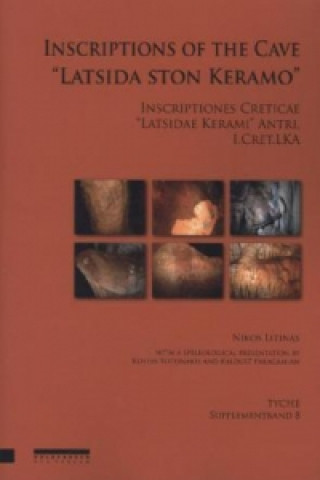
Kod: 02367034
Inscriptiones of the Cave "Latsida Ston Keramo"
Autor Nikos Litinas, Verein Tyche
The volume is the edition of a series of graffiti from a remote cave in Crete. The cave żLatsida ston Keramoż was not well known and was difficult to locate. Although there were reports of archaeological findings on the surface, n ... więcej
- Język:
 Angielski
Angielski - Oprawa: Miękka
- Liczba stron: 128
Wydawca: Holzhausen, 2014
- Więcej informacji o książce

Zobacz książki o podobnej tematyce
-

Little Prince
92.95 zł -23 % -

100 UK Graffiti Artists
182.19 zł -11 % -

Surviving Childhood
60.09 zł -

Guardian of the Republic
111.34 zł -10 % -

Relaxation in Polymers
563.27 zł -

Ontology and Dialectics 1960-61
390.42 zł
Powiadomienie o dostępności
Wpisz swój adres e-mail, aby otrzymać od nas powiadomienie,
gdy książka będzie dostępna. Proste, prawda?
Więcej informacji o Inscriptiones of the Cave "Latsida Ston Keramo"
 Opis
Opis
The volume is the edition of a series of graffiti from a remote cave in Crete. The cave żLatsida ston Keramoż was not well known and was difficult to locate. Although there were reports of archaeological findings on the surface, no official archaeological work has ever been undertaken. The introduction to this volume is divided into two chapters. The first one contains a collection of the described or published Greek inscriptions and graffiti carved or written on the walls, either inside or in the entrances, of natural caves and caverns dated from the fifth century B.C. to the sixth century A.D. The second chapter is an English translation of a paper published in Greek by the speleologists K. Foteinakis and K. Paragamian in the third Pancretan Speleological Symposium. This is included as it will help the reader to understand the natural underground space and environment of the cave. The graffiti are carved or scratched (graffiti) into or written (dipinti) on the flowstones, the walls, the stalagmites or the columns of the cave. About 40 names, masculine or feminine,appear. None of the bearers of the names can be identified with a certain person known from other Cretan inscriptions or literature. The possible origin of the identifiable names in the cave is Crete (mostly cities of the eastern Crete), but other areas, e.g. Thessaly, Boeotia and the Aegean islands, should not be excluded. Based on the internal evidence and the palaeographical details a date that could be assigned to these graffiti is from the first century B.C. until the end of the second century or early third century A.D. The people who inscribed these names were either natives or migrants, who found themselves in this area of Crete for a certain purpose, and found a good reason to spend some time visiting this remote place. They might have been local farmers or/and shepherds or travelers or/and traders or people who were trying to escape from their social condition within the community and/or from its laws, who found shelter in this cave. If the graffiti (or some of the graffiti) are dated to the Hellenistic period in Crete, a second possibility is that all these men could have been members of a garrison or a patrol whose duty was to protect the countryside or the roads from żenemiesż or żoutsidersż. The third possibility concerns the well-known ritual kidnapping of young boysby adults, which has been recorded by Ephorus (cited by Strabo).
 Szczegóły książki
Szczegóły książki
- Pełny tytuł: Inscriptiones of the Cave "Latsida Ston Keramo"
- Podtytuł: Inscriptiones Creticae Latsidae Kerami Antri, I.Cret.LKA
- Autor: Nikos Litinas, Verein Tyche
- Język:
 Angielski
Angielski - Oprawa: Miękka
- Liczba stron: 128
- EAN: 9783902976086
- ISBN: 390297608X
- ID: 02367034
- Wydawca: Holzhausen
- Waga: 324 g
- Wymiary: 240 × 169 × 5 mm
- Rok wydania: 2014
Ulubione w innej kategorii
-

Dune
50.34 zł -3 % -

Haunting Adeline
125.51 zł -1 % -

Berserk Deluxe Volume 2
212.74 zł -1 % -

White Nights
10.94 zł -28 % -

Powerless
48.63 zł -11 % -

Atomic Habits
57.37 zł -28 % -

Dune Messiah
46.22 zł -3 % -

Berserk Deluxe Volume 3
217.87 zł -3 % -

One Day
34.26 zł -44 % -

Berserk Deluxe Volume 1
211.33 zł -2 % -

Iron Flame
60.99 zł -28 % -

Surrounded by Idiots
36.67 zł -28 % -

Harry Potter and the Prisoner of Azkaban (Minalima Edition)
170.03 zł -2 % -

Gravity Falls Journal 3
89.03 zł -

Heaven Official's Blessing: Tian Guan Ci Fu (Novel) Vol. 1
89.43 zł -

The Creative Act
102.70 zł -12 % -

Dune
47.22 zł -23 % -

Hunting Adeline
126.01 zł -4 % -

A Little Life
48.63 zł -11 % -

Children of Dune
46.62 zł -2 % -

Heaven Official's Blessing: Tian Guan Ci Fu (Novel) Vol. 2
77.57 zł -14 % -

Bungo Stray Dogs, Vol. 8 (light novel)
65.41 zł -4 % -

Percy Jackson and the Olympians 5 Book Paperback Boxed Set
126.72 zł -34 % -

Solo Leveling, Vol. 1
86.52 zł -3 % -

The Prisoner's Throne
44.81 zł -12 % -

Court of Thorns and Roses
33.86 zł -31 % -

Cry Baby Coloring Book
47.22 zł -1 % -

Fourth Wing
71.75 zł -15 % -

Icebreaker
37.48 zł -21 % -

Berserk Deluxe Volume 6
217.87 zł -3 % -

Avatar, the Last Airbender: The Kyoshi Novels (Box Set)
165.81 zł -4 % -

The 48 Laws of Power
98.28 zł -14 % -

House of Leaves
123.80 zł -3 % -

Twisted Lies
36.67 zł -28 % -

Dune Messiah
49.53 zł -13 % -

No Longer Human
56.37 zł -8 % -

48 Laws Of Power
60.99 zł -28 % -

Twisted Games
35.06 zł -31 % -

Caraval Paperback Boxed Set
175.15 zł -3 % -

Solo Leveling, Vol. 2
74.86 zł -23 % -

Open Circuits
169.03 zł -2 % -

Berserk Deluxe Volume 5
223.80 zł -

Heaven Official's Blessing: Tian Guan Ci Fu (Novel) Vol. 3
78.08 zł -13 % -

Berserk Deluxe Volume 4
208.42 zł -3 % -

Court of Mist and Fury
33.86 zł -31 % -

SOLO LEVELING V08
88.23 zł -1 % -

English File Upper Intermediate Multipack A (4th)
92.85 zł -1 % -

CHAINSAW MAN V14
43.51 zł -21 % -

Before the Coffee Gets Cold
31.55 zł -31 %
zadowolonych klientów
Od roku 2008 obsłużyliśmy wielu miłośników książek, ale dla nas każdy był tym wyjątkowym.
Copyright! ©2008-24 libristo.pl Wszelkie prawa zastrzeżonePrywatnieCookies



 21 milionów książek
21 milionów książek Dostawa 10.99 zł
Dostawa 10.99 zł (32) 444 93 66 (8-15.30h)
(32) 444 93 66 (8-15.30h)